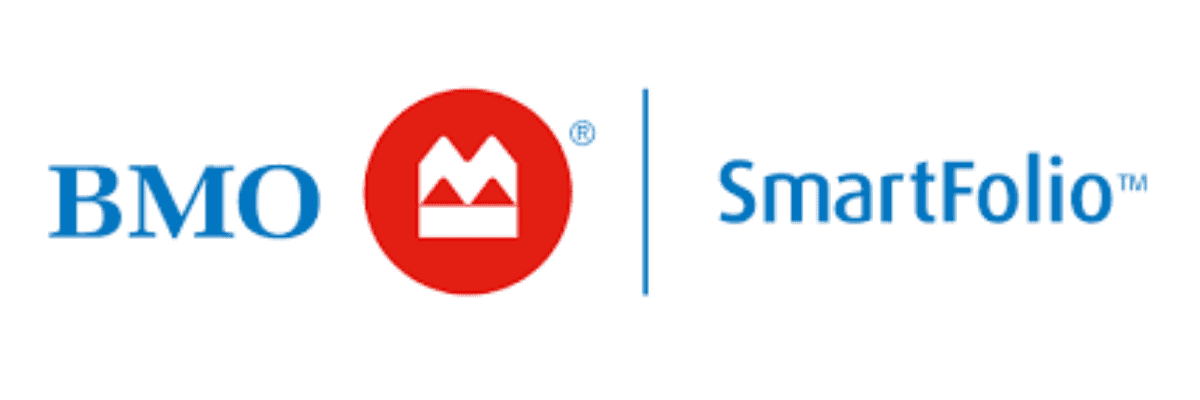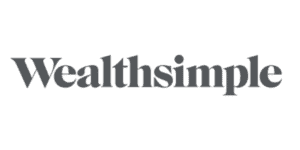Wealthsimple vs BMO in 2025
At first glance, a modern fintech company like Wealthsimple and an established financial giant like BMO couldn’t be more different. Yet, with the new push to index investing over the last decade, both financial institutions have managed wealth platforms that we ranked in my Best Robo Advisors in Canada list. Of course, they also include online brokerage options as well, but those have slid down my list of the Best Online Brokers in Canada.
Choosing the right DIY investing platform can feel like a daunting task, especially when you’re weighing fees, features, and overall value. That’s why we’ve put together this side-by-side comparison of Wealthsimple Invest and BMO Smartfolio, as well as Wealthsimple Trade and BMO Investorline. Our goal is to help you cut through the noise, understand the differences, and see how each platform stacks up.
By the time you’re finished reading, you’ll have a clear understanding of what each platform brings to the table. We also recommend checking out how our top rated robo advisor stacks up in our Justwealth Review, and how our top rate brokerage account compares in our Qtrade Review.
Wealthsimple Invest vs BMO Smartfolio: Quick Comparison Chart
While we recommend reading our Wealthsimple Review and our BMO Smartfolio Review for more context, we’ve summed up the important info here:
BMO SmartFolio | Wealthsimple Managed Investing | |
Management Fees |
|
|
MER | 0.2-0.35% | 0.12-0.15% For Standard ETFs |
Investment Options | BMO ETFs only | 13 ETFs (10 standard, 2 SRI, 1 Halal), a variety of top providers. |
SRI Options | ||
Minimum Investment | $1,000 | None |
Portfolio Options | 5 model portfolios | A choice of 9 portfolios (3 standard, 3 SRI, 3 Halal) |
Account Types | RRSP, Spousal RRSP, TFSA, RRIF, Spousal RRIF, RESP, unregistered | RRSP, Spousal RRSP, TFSA, LIRA, RRIF, LIF, RESP, unregistered |
Returns | 1.25% to 6.39% annualized growth | 1.96% to 5.54% annualized growth |
Safety | CIPF protection up to $1 million + Bank-level encryption | CIPF protection up to $1 million + Bank-level encryption |
Customer Service | Easy to access (human) advisors | Easy to access (human) advisors |
Additional Services |
|
|
Promo | None | $50 sign-up bonus |
Sign Up |
Wealthsimple vs BMO: Similar Service, (Very) Different Institutions
Wealthsimple is a Fintrac-registered money services business that was founded in 2014 with its robo-advisor service, Wealthsimple Invest, as its flagship product. It has since branched out into DIY investing with Wealthsimple Trade and cryptocurrency investing with Wealthsimple Crypto.
Even though it’s much newer, Wealthsimple still has over 1.5 million customers and over $15 billion in assets under management. They offer a number of services in addition to their robo-advisor, including:
- Wealthsimple Spend (which functions like a bank account)
- Wealthsimple Tax (a tax filing platform)
- Wealthsimple Crypto (a crypto trading platform)
- Wealthsimple Trade (a discount online brokerage – more on this near the end of this article).
Compare that to BMO, which was the first bank in Canada (founded over 200 years ago) and has over $332 billion in assets under management.
BMO pioneered big bank robo-advisors when it launched Smartfolio in 2016. Other banks are gradually following, but so far the only other established robo is RBC Investease, which we featured in our Wealthsimple vs RBC comparison).
BMO prefers the term “online portfolio management” over “robo-advisor” because they focus heavily on human interaction. Their portfolios are actively managed by a team of Portfolio Managers and rely a bit less on computer algorithms than their competition.
From what we’ve seen, there’s no indication that the personal management aspect makes a huge difference in performance, but think of it as the big bank touch (one that you pay extra for).
Wealthsimple vs. BMO: Security
Both Wealthsimple and BMO Smartfolio are legit, regulated robo-advisors. Your accounts are held by custodial brokers which are members of the Canada Investor Protection Fund (CIPF) and regulated by the Investment Industry Regulatory Organization of Canada (IIROC).
Both take data security seriously. They use bank-level encryption and firewalls at every level. You can trust each company to protect your information as well as your money.
Wealthsimple vs. BMO: Annual Fees
One major difference between Wealthsimple Invest and BMO Smartfolio is the fee structure. BMO’s is a bit complicated, so we’re going to break it down with a real-life example so you can see what the pricing means for you.
BMO charges fees according to the following tiers:
- 0.7% for the first 100K
- 0.6% for the next 150K
- 0.5% for the next 250K
- 0.4% for over 500K
But it’s even more complicated than that because their fee structure is cumulative.
For example, if you have $250,000 to invest, your total fees look like this:
$100,000 x 0.7% = $700 + $150,000 x 0.6% = $900
$700 + $900 = $1600 to manage that $250,000.
Meanwhile, Wealthsimple charges a straight percentage of the account (0.5% for accounts under $100,000 or 0.4% for larger accounts). This sample $250,000 account would be charged a flat 0.4% fee.
$250,000 x 0.4% = $1,000. That’s a steep difference!
BMO is quick to point out that their fees are lower than a typical (1.75%) traditional investing fee – and that’s true, at 1.75% you’d be paying $4,375. But it’s still 60% more than you’d pay with Wealthsimple Invest, and in the case of our example, that’s $600 that could be going into your pocket (or back into your investment account).
Wealthsimple vs. BMO: MER
Any ETF has a management expense ratio – a management fee that is charged behind the scenes and is expressed as a percentage of the total investment. MERs can vary widely – and in the case of Wealthsimple Invest and BMO Smartfolio, they do!
Wealthsimple’s standard ETFs have an MER of 0.12-0.15%, which is extremely low compared to industry standards. The MERs for their socially responsible investment (SRI) ETFs range from 0.21-0.23%, while the MERs for their Halal ETFs range from 0.25-0.5%.
BMO’s MERs sit between 0.2% and 0.35% – on the high side of normal for ETF MERs in general, but about double Wealthsimple’s standard ETF MERs.
Wealthsimple vs BMO: Additional Fees
Wealthsimple Invest doesn’t charge transfer fees or withdrawal fees. In fact, if you transfer over $5,000 in investments to Wealthsimple, they’ll reimburse you for the incoming transfer fee. They do charge a 0.4% foreign exchange fee, but that’s really it.
Meanwhile, BMO charges a host of additional fees including:
- Transfer-out of a Non-Registered or Registered Account (Full and partial) ($135)
- Partial withdrawal of a Registered Account (excluding TFSA and RRIF accounts) ($25)
- Full Deregistration of a Registered Account (excluding TFSA and RRIF accounts) ($100)
- Cheque requests ($10)
- Paper statement requests ($5)
- Foreign Currency Conversions (1.8%)
We’re not fans of fees for every little thing, so we consider this extensive menu of charges to be a point against BMO.
But we get it – BMO is a traditional bank, and this is what (many) banks do.
Wealthsimple vs. BMO: ETF Selection
Because Bank of Montreal is an ETF provider, it’s not a surprise that their Smartfolio service builds its portfolios out of BMO ETFs. They’re recognized as one of the top ETF providers, so this isn’t a terrible thing.
However, we question the tactic of limiting portfolios to a single ETF provider. There are many excellent ETFs available from other providers, including many of the Best Canadian All-in-One ETFs and Best Dividend ETFs in Canada.
A typical portfolio from Wealthsimple includes ETFs from Vanguard, iShares, and BMO, which gives them a much wider field of candidates to choose from. We’re not sure if this explains why BMO doesn’t offer socially responsible investment portfolio options…but we do think it’s important to point out that they don’t.
Wealthsimple has SRI options, but if you prefer a big bank experience, check out RBC Investease, which offers them as well.
Wealthsimple vs. BMO: Portfolio Options
BMO offers 5 basic portfolio templates from Capital Preservation (lowest risk) to Equity Growth (most aggressive). Smartfolio portfolios are managed by a team of Portfolio Managers and Credited Financial Analysts who monitor each portfolio daily.
Wealthsimple Invest has 3 basic portfolio templates: Conservative, Balanced, and Growth for their standard, SRI, and Halal portfolios. Within those 3 main types of portfolios, they adjust asset allocation based on a risk-tolerance scale of 1-10. Wealthsimple does have Portfolio Managers on staff, but the impression we get from their marketing is that the algorithms handle a certain amount of the day-to-day details.
We’re not saying that as a knock against Wealthsimple, for the record. They’re our most recommended robo-advisor, so clearly, we think they’re doing an excellent job. And management by algorithm is pretty much the point of robo-advising in the first place.
Wealthsimple vs BMO: Account Selection
Both Wealthsimple Invest and BMO Smartfolio offer the following account options:
- RRSP
- TFSA
- RRIF
- RESP
- Unregistered
Wealthsimple also offers spousal RRSPs, LIRA, and LIF accounts.
Wealthsimple vs. BMO: Performance
Annualized returns are a problematic metric for picking a robo-advisor. Markets change constantly, and differences in performance generally have nothing useful to reveal about the quality of the platform.
However, if you’re interested in BMO Smartfolio’s performance, they put their numbers front and centre on the pages for each portfolio.
Wealthsimple shares our opinion of the effectiveness of performance tracking – but the numbers are there if you dig for them. BMO’s annualized returns currently range from 1.25% to 6.39% returns while Wealthsimple ranges from 1.96% to 5.54%.
Again, be warned: this means next to nothing out of context—these numbers are about half what they were in 2021, and yet we’re still recommending these advisors because investing is a long term game and they can’t be blamed for the declining state of the market in 2022.
The best thing you can do when you’re picking a robo-advisor is pay less attention to the annual returns and more attention to the features and services. Pick the one that works best for you, invest your money, and leave it alone. It’ll all even out over time.
Wealthsimple vs. BMO: Sign-up
Signing up for both Wealthsimple Invest and BMO Smartfolio is easy:
- You answer some questions to determine your investment goals, timeline, and risk tolerance
- You enter some basic personal information
- You fund your account.
If you want to add regularly to your account balance, both Wealthsimple Invest and BMO Smartfolio allow you to set up recurring auto-deposits.
Wealthsimple vs. BMO: Minimum Balance
Wealthsimple allows you to begin investing with as little as $1. BMO Smartfolio requires a minimum balance of $1,000.
This isn’t uncommon – other robo-advisors like Nest Wealth and ModernAdvisor have the same requirement. But it’s always nice when a company like Wealthsimple makes investing accessible to everyone, regardless of whether they have $1,000 in their account.
Wealthsimple vs. BMO: Perks
Part of Wealthsimple’s tiered pricing is tiered perks. Investors with over $100,000 in assets receive not only a discount but also features such as personalized financial planning and tax-loss harvesting. Investors with over $500,000 receive even more perks, including a personalized financial plan and 50% off health insurance for residents of Ontario.
BMO automatically has a certain prestige attached to the name… but they don’t offer any concrete perks to go with it.
You know how we feel about perks (we’re for them—unless they’re acting as a substitute for a quality robo-advising service).
Wealthsimple vs. BMO: Available Promotions
Wealthsimple Invest is offering our readers a welcome bonus: $50 cash if you open an account and invest $500.
Wealthsimple vs. BMO: Mobile App and Website
BMO Smartfolio doesn’t have a standalone app, but it does have a streamlined and intuitive online platform. It gives you all the information you need, from a bird’s eye view to details of one specific holding.
Wealthsimple Invest has its own app, which is also streamlined and easy to navigate. You can view your asset allocation, monitor your performance, and contact Wealthsimple’s investment team.
While both platforms are well-designed and intuitive, we do give extra props to Wealthsimple for adding a mobile app to an excellent browser-based platform.
Wealthsimple vs. BMO: Customer Service
Wealthsimple has a team of Portfolio Managers and assistants available by phone, email, app, or Skype during business hours every day. Likewise, BMO has a team of Smartfolio Advisors available by chat, phone, or email.
Both companies dedicate teams of real people to making sure you get the help you need. And that’s, frankly, priceless (although paying less is always good!).
Wealthsimple Trade vs. BMO Investorline: Self-directed Trading
Bank of Montreal and Wealthsimple both offer self-directed, DIY trading options as well as robo-advising. Wealthsimple Trade is one of the few no-fee platforms in Canada and BMO Investorline is known for its stellar customer service.
We’ve laid out the major features head to head for easy comparison:
| Wealthsimple Trade | BMO Investorline | |
| Investment Options | Stocks and ETFs only | Stocks, ETFs, Options, Mutual Funds, Bonds, GICs, Gold & Sliver |
| Free ETFs? | Free to buy and sell ALL ETFs | 80+ ETFs free to buy and sell |
| User Experience | Buggy web platform, app lacks resources, customer service is almost nonexistent | Very good platform, second only to Qtrade, solid customer service |
| Account Fees | None | $25/Quarter (unless your balance is over $25,000) |
| Trading Fees | None | $9.95/trade (except listed free ETFs) |
| Safety | CIPF member, IIROC regulated, encrypted | CIPF member, IIROC regulated, encrypted |
| Full Review | Wealthsimple Trade Review | BMO InvestorLine Review |
While we love Wealthsimple Invest, we frankly find Wealthsimple Trade underwhelming. It’s free to use, but they make their profit by selling data and skimping on customer service. We also don’t love the buggy platform. And while BMO is more functional and has more variety, they charge you a quarterly fee, plus $9.95 for most trades. Neither is ideal.
If DIY investing is more your scene, we recommend looking at Qtrade or Questrade instead of either BMO or Wealthsimple. They’re more functional and have better customer service than Wealthsimple while providing better value than BMO.
Wealthsimple or BMO? Frequently Asked Questions
Wealthsimple vs BMO vs Canada’s Top Platforms
While Wealthsimple is Canada’s largest robo advisor and BMO was the first of Canada’s big banks to roll out a robo advisor, I wouldn’t currently put them at the top of the robo advisor rankings. I will say that Canadian investors could do a lot worse. Both companies are safe and trustworthy as far as responsibly housing your investments and protecting them from fraud.
That said, if you read our Justwealth Review you’ll see just how bad their investment performance has been compared to my #1 choice. Justwealth also has an excellent promo offer on right now that is worth checking out.
Their online brokerage platforms are in a similar position, where they can certainly do the basic job just fine – but they fall significantly below Qtrade. Check out my Qtrade Review for more info on the latest offers from Canada’s #1 brokerage option.
If you want the simplicity of keeping all your finance under one roof, using BMO Smartfolio or BMO Investorline are much better options than not getting started at all. Similarly, if Wealthsimple’s excellent user interface and top-notch design are what you need to make your monthly RRSP/TFSA contribution, then just sign up now and figure the rest out as you go.
Way too many Canadians can get lost in the minutiae when it comes to these things and miss the forest due to focusing on inconsequential trees. In the BMO vs Wealthsimple battle, I think whichever platform you’re most comfortable with and most likely to use consistently is the winner!
I've Completed My Million Dollar Journey. Let Me Guide You Through Yours!
Sign up below to get a copy of our free eBook: Can I Retire Yet?












